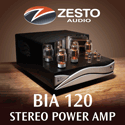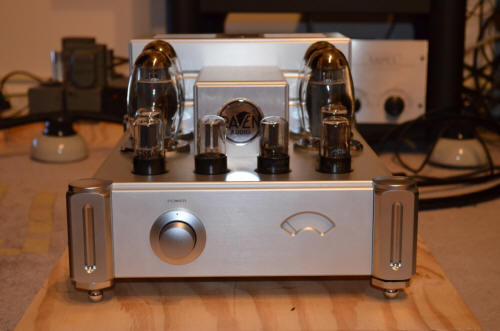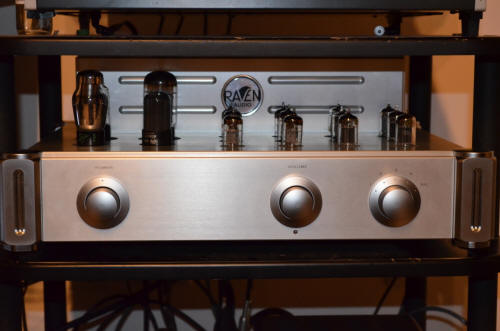|
|
You are reading the older HTML site
Positive Feedback ISSUE 72
raven audio Silhouette Reference Preamp and Amplifiers - A Road Less Traveled as reviewed by Mark Pearson
Raven Audio is a relative newcomer to the world of the high-end audio community. Raven Audio is owned by a gentleman by the name of Dave Thomson. Prior to starting Raven Audio, Dave owned a marine construction company located on Lake Livingston in Texas. For health reasons, Dave decided it was time to sell his marine construction company and move on to something he thought would be more fun and less stressful. One sleepless night, while his company was still up for sale, Dave was surfing the web looking at pictures of tube audio gear when he happened upon a website of some really cool looking tube gear made in South Korea. Dave sent an email to the creator of the South Korean tube audio products and said, "Hello from Texas." Little did Dave know at the time that his email would lead to the founding of Raven Audio. From Dave's simple email, a relationship formed with the engineer in South Korea responsible for designing and building the tube audio gear that Dave found while surfing the web one restless night. That engineer's name is SE Han and he has been designing and building tube gear since 1968. As it turned out, SE Han had lived in the U.S. for a number of years in none other than the state of Texas. SE Han had been employed by Texas Instruments where he worked as an assembly line engineer. As one thing led to another, SE Han advised Dave that if he heard his products, Dave would no longer be able to enjoy either of the two high-end systems that he owned. I'm not going to name names here, but the tube gear Dave owned is well-known and highly thought of in the audio community. Dave rolled his eyes when he heard SE Han's proclamation, but the truth to him was soon revealed. SE Han decided to come to Texas to meet Dave Thomson and brought a preamp and amplifier with him to demonstrate his designs. After hearing the amp and preamp SE Han brought with him in his system, Raven Audio was born six months after Dave sold his marine construction company. An agreement was struck between Dave Thomson and SE Han that SE Han would be a subcontractor to Raven Audio, and he would design all of the circuits for Raven Audio. Raven Audio owns the rights to all of the products they make, and all of Raven's products are made in the tiny town of Chita, Texas. When I started my review of the Raven Audio products, I decided that I would insert the Silhouette Reference monoblock amplifiers into my system first in order to get a handle on their sound with the rest of my system before I jumped in whole hog and installed the Raven Silhouette Reference preamp. Raven Audio keeps a stock of NOS tubes and allows their customer a choice of buying NOS output tubes and input tubes, or buying current production tubes. Raven sent me two quads of real Tung Sol 6550 output tubes as well as two matched quads of KT-150 tubes which normally come stock with the Silhouette Reference monoblocks. The Silhouette Reference monoblocks are 100 watt push-pull design amps that are auto-biased, which means you don't have to set and maintain the bias of the output tubes. The circuit design of the Silhouette Reference amps is unusual in that all of the input tubes are 12v octal tubes. The majority of push-pull tube amps you see in the market place use 9 pin miniature tubes for the phase inverter and driver, with the normal accompaniment of the 9 pin miniature tubes being usually between 2-4 tubes. The Silhouette Reference amps use a total of 6 12v octal tubes in each amp. There is a set of unbalanced RCA inputs and a set of balanced XLR inputs. The front of the amp has an on/off knob that you turn to the right to power the amp on. The off/on switch is lit by a soft blue LED when placed in the ‘on' position. Each amp also has a meter on the front panel that is backlit in blue. There are no markings on the face of the meter, but no matter how loud I played the Raven amps, the meters never seemed to work very hard. The Raven amps always sounded like they were just loafing along and were never being pushed hard. These amps are also point-to-point wired, and use premium components in their construction.
All of the Raven Audio products under review here are machined from solid billet aluminum, and the design and the quality of the machine work is simply beautiful. The corner posts found on each piece of their gear are the same. There is a machined flange with facets so you can easily grip the flange on top of each of the ball feet that allows you to turn the flange to perfectly level each piece of gear on your rack. I installed the NOS Tung Sol 6550 tubes and the 12v octal tubes into the Silhouette Reference amps and began the review process. My reference preamp is the Krell KRC-HR and it mated very well with the Silhouette Reference amps. The amps are very quiet, meaning they have a very low noise floor, which is important to me. I have spent the last several years trying to lower the noise floor of my system as much as I can. Introducing new components into my system that raise my noise floor is not something I would welcome. I can understand why many people love the sound of the original Tung Sol 6550s. They have a luscious creamy midrange that is oh-so-easy on the ears. However, they don't have the strong bottom end of the original GE 6550. I decided to switch over to the Tung Sol KT-150s, which is what most people will purchase when they buy these amps, and spent the rest of my review time with the KT-150s in place. I listened to a variety of music that included, jazz, rock and roll, classical, and other genres in-between. The first LP up to the plate was Johnny Cash-American IV: The Man Comes Around (American). The title song "The Man Comes Around" was simply thrilling to hear. It sounds like you are in the studio with Johnny and listening to him sing live into the microphone. This recording is loud, but it still has some really nice dynamics. The acoustic guitar sounds alive, and you can hear each chord ring out. The piano also sounds very real with good dynamics and a solid bottom register coming from the left hand. The next song up was "Hurt," and listening to this song over a good system is an intense experience as the music builds to a crescendo. Again my notes say the acoustic guitar was very natural sounding, and the way the chords ring out just sounds so true that it helps suspend disbelief that you are listening to a recording versus hearing the music being played live. I switched over to a Who LP, Live at Leeds (Track 2406 001 reissue). If Live at Leeds isn't one of the best live rock LPs ever recorded, I want to know what is. This live rock recording is simply stunning for the day (1970) or for any other day for that matter. All of the instruments are miked very well and in balance with each other, ditto for Roger Daltrey's voice. Pete Townsend's machine gun riffs are simply there in all of their loud glory, and you can even hear his amps humming in the background. The Raven amps allow this recording to shine in all of its loud glory while maintaining every bit of the dynamic range encoded into the grooves.
At this point, I need to say a word about the KT-150 tubes when used in the Raven amps. The more hours I put on the KT-150 tubes and the Raven amps, the more I liked them. I think many of us have heard both 6550 and KT-88 tubes over the years that had one kind of bass, another type of midrange, and yet another type of highs. The KT-150 tubes in the Raven amps are cut from the same cloth to my ears. From top to bottom, nothing stood out in relation to the other parts of the frequency spectrum and called attention to itself. I will say that you can hear a difference in the extension and tightness of the bass of the Raven amps when driven by my Krell KRC-HR line stage, but it comes at the expense of some of the magic that the Raven Silhouette Reference preamp brings to the table. The next LP I played was Duke Ellington, Jazz Party in Stereo (45 RPM version from Org). While listening to the cut "Malletoba Spank" my notes simply said, "Crazy good. It couldn't sound any more real unless you really were there. The low-level detail is simply astounding. You can hear sounds at a very low level as they emerge from a super-low noise floor." This theme of being "real" sounding kept repeating itself throughout my time listening to the Raven electronics. Next I inserted the Raven Silhouette Reference preamp into my system to power the Raven amps. The Silhouette Reference preamp is also a little off the beaten path from lots of tube preamps on the market. The power supply and voltage regulation are all vacuum tubes and the power supply can use a variety of different rectifier tubes (5Y3/5AR4/5V3A/5R4) as well as a 6B4G regulator, a 6SN7 used as a "voltage adjustor" and one OA3 which is a gas regulator tube. The line stage uses a pair of 12AU7s, a pair of 12AT7s, and a pair of 6922 tubes. The built in phono stage uses six 12AX7s. The Silhouette Reference preamp is also point-to point wired. The built in phono stage is only compatible with MM and high-output moving coil cartridges that are also compatible with a fixed 47k input impedance. Unfortunately, my cartridge is the Dynavector XV1s, which is a low output cartridge that needs to be loaded down to a much lower impedance than 47k, so I was unable to listen to the phono stage. There are 3 sets of RCA line level inputs, one RCA phono input, one balanced XLR input, and one set of RCA output jacks and one set of XLR output jacks. I used balanced connections between the Raven preamp and power amps.
Across a variety of music, my notes for the Raven preamp and amps as a combination were very positive. The tonal colors are simply gorgeous with this combo. You can hear every tonal inflection of voices in a way that seems to get smeared or lost with some other gear. For instance, on Ella and Louis, a 1956 recording, both voices are incredible to listen to. Ella has a buttery smooth voice that just melts your heart and, Louis Armstrong with his one of a kind voice that has that timbre and vibrato that is so easily recognizable. All of the nuances and tonal inflections of both of their voices are just brought to life in a way that takes this recording to a new level in my experience. As further testament to the neutrality of the Raven components, every recording you play will sound different. There is never a ‘sameness' of sound that prevails from recording to recording. Each recording stands on its own merits. The Raven gear just tells the truth and shows you what is on each recording. When I listened to the LP of Thelonious Monk Misterioso (Riverside RLP 1133), I could immediately tell that the highs are somewhat rolled off on this 1958 recording. They didn't have to be given the technology that was available even then. I think some of the softness in the highs is due to the distant mike placement. Misterioso is a live recording and, unlike lots of live jazz recordings, you don't get the perspective that you are sitting close to the stage. The recording perspective places you well back into the audience. Having said all of that, Misterioso is still a really enjoyable recording to hear through the Raven gear. So now it's time to pick a few nits because after all, that's what we reviewers are supposed to do. I believe that Raven should be engraving/silk screening/machining the valve numbers next to each socket (V1- Vxx) so users know exactly what socket to plug each tube into. When you have a preamp that uses 12 tubes between the phono stage and line stage and another 4 tubes for the power supply, you really want to make it a no-brainer for people to insert the correct tube in each socket. Ditto for the power amps as each one uses 10 tubes. I have been around tubes my entire life so while it wasn't a big deal for me, it certainly could be a problem for the less experienced.
The Raven Silhouette Reference preamp is a minimalist design. There are no tone controls which is fine with me. There also isn't a balance control which is fine with me. It also doesn't have a mute switch which isn't so fine with me. I understand why Raven eliminated it, but that doesn't mean I still don't miss having it. I personally don't like having to adjust the volume to zero before I change LP sides or switch inputs. Also, the Silhouette Reference preamp comes with options for the volume control. The standard pot is an ALPS motorized potentiometer that comes with a remote that allows you to adjust the volume. The higher-priced option pot is a Tokyo Ko-on attenuator which is what my preamp was fitted with. There is currently no remote available for the Tokyo Ko-on attenuator. The preamp turns on with the same on/off switch as used on the monoblock amps. You simply turn the switch to the right and the soft blue LED light on the power switch lights up. Both the volume control and the input selectors have darker blue and brighter LEDs that glow upon the preamp being switched on. The LED on the source selector switch blinks upon turn-on until the preamp has warmed up and then the LED stays on. I would prefer they both used the softer blue LED that is used in the on/off switch. With regards to the Tokyo Ko-on attenuator, this has to be the stiffest attenuator I have ever operated in my life. It's like performing reverse arm wrestling every time you go to turn the volume up and regular arm wrestling when you go to turn the volume down. I don't know if the amount of stiffness is adjustable or not, but if it is, it should be dialed back some. All the more reason why I missed having a mute switch.
In summary, I immensely enjoyed my time with the Raven gear, and I shall miss what it brought to my system. Time after time as I sat in my chair listening to music come to life, I said to myself that the sound I was obtaining through the Silhouette Reference preamp and power amps is the sound that lots of audiophiles are chasing. Raven Audio's products deserve to be heard. If you are shopping for tube gear in the price range of Raven Audio gear, I highly recommend you find a way to listen to Raven Audio products before you make a purchasing decision. Mark Pearson
Raven
Silhouette Reference Preamp
Output Impedance: <200 ohms
Raven
Silhouette Reference Monoblocks
Output: 100 watts per channel
Raven Audio
|














